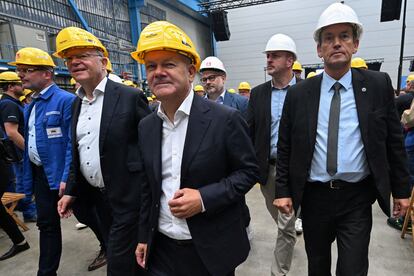Germany’s lack of public investment is weighing on its economy and holding back the EU | Economy


From the engine of the European economy to a mere galley. Germany has been in stagnation – or rather, in decline – for almost two years now. It has been caught between several structural changes and crises that have put it on the wrong foot, such as the forced abandonment of Russian gas or the decline in demand for products from China. Made in Germany. Both of these put pressure on the country’s important industrial sector. Added to this is the widespread lack of public investment, as can be seen, for example, from the data and forecasts managed by the European Commission, in which the European giant is indeed more than half a point behind the community average in GDP in 2023, 2024 and 2025.
That Germany is weak is not good news for the rest of the European Union and the Eurozone, even if there are rulers who brag when economic data comes out from Eurostat, the European statistical office. “We are better than all the big EU countries, and we beat the Germans,” wrote Polish Prime Minister Donald Tusk on the social network X. His country has certainly achieved impressive numbers. Poland’s GDP grew by 1.5% in the second quarter of this year. The Netherlands also did very well, growing by 1%. Spain is another big economy, with strong growth in the April-June period, up 0.8%.
“German stagnation is dragging down the entire eurozone. This is very noticeable in places like the Czech Republic, which are so tied to German supply chains,” explains Sander Thorduar, chief economist at the Centre for European Reform (CER), a think tank that specialises in Germany’s role in the EU. “As a rule of thumb, if you look at the (economic) literature, one percentage point of fiscal stimulus in Germany (as a percentage of GDP) should add about 0.1% to its neighbours, from Poland to the Netherlands to France. In contrast, permanent stagnation and austerity on autopilot in Germany is dragging down growth everywhere else.”
The industrial power’s economy contracted in the second quarter, surprising most experts and economic institutes, who had expected stagnation or modest growth. Germany’s weakness is becoming chronic. It has been fluctuating slightly above and below zero since the spring of 2022, and no significant improvement is expected in the third quarter of this year, says Klaus Wohlrabe, research director at the Ifo economic institute. “The German economy is trapped in a crisis,” he says.
This is due to a lack of investment, says Thorduar: “The German economy has the potential to create new companies and markets, but this process is slowed down by poor infrastructure, gaps in digitalisation, too much bureaucracy and slow capital markets. This slows down the dynamism and turnover of companies. Example: of the 40 largest companies listed on the German DAX index, 23 were founded in the 19th century or earlier, and only two were founded this century. “This is the long-term damage from the absolute lack of public investment or reforms over the past 15 years.” The researcher calculates, for example, that the railway network needs investment of 45 billion euros by 2027 and regrets that “net expenditure on higher education increased by less than 1% adjusted for inflation between 2010 and 2018, compared to 6% between 2010 and 2018.” The Netherlands, 15% in the US and a staggering 116% in Estonia.”
The lack of investment is holding back the economy, says Wohlrabe, who blames the uncertainty of economic policy. “We know from our surveys that more than 40% of companies report a lack of orders.” Meanwhile, private consumption is not growing, despite rising wages. “Consumers are somewhat reserved when it comes to spending. There is some caution regarding the inflation rate, which has increased slightly. German consumers are very sensitive to inflation,” he recalls in an interview with EL PAÍS.
Germany also has problems with competitiveness, emphasizes Jens Boysen-Hogrefe, a professor at the University of Kiel, “which has not improved in recent years.” China’s competitive advantage is of particular concern in Germany. “The aggressive strategies of the Chinese manufacturing sector affect Germany more than other countries because the Asian country focuses on the automotive industry, machinery and equipment, and these are precisely the sectors in which Germany was strong,” he notes.
For Boysen-Hogrefe, weak exports and an ageing population are the main explanations for Germany’s economic situation. “Politicians must do everything necessary to increase public investment, because if Germany’s competitiveness is weak, it is largely due to the lack of adequate infrastructure,” he notes.
Meanwhile, voices are growing that blame the debt brake, the debt limit included in the German constitution, for the economic situation. According to experts at the Hans Böckler Foundation’s Institute for Macroeconomics (IMK), who are linked to trade unions, this limit hinders decisive investments in the energy transition and infrastructure.
Since the debt brake has been suspended since 2020, it has not contributed to the worsening of the economic situation, but “it is true that it could do so in the future,” the Kiel expert notes. “There is a hellish debate going on in Germany with politicians who may not want to explore the public investment options that the debt brake opens up and prefer to maintain the argument that it hinders public investment and thus eliminates it entirely. However, I think that yes, it is very likely that it will act as a brake on public investment in the future,” he explains in a telephone interview.
Keep up to date with all the information Economy And Business V Facebook And Xor in ours weekly newsletter